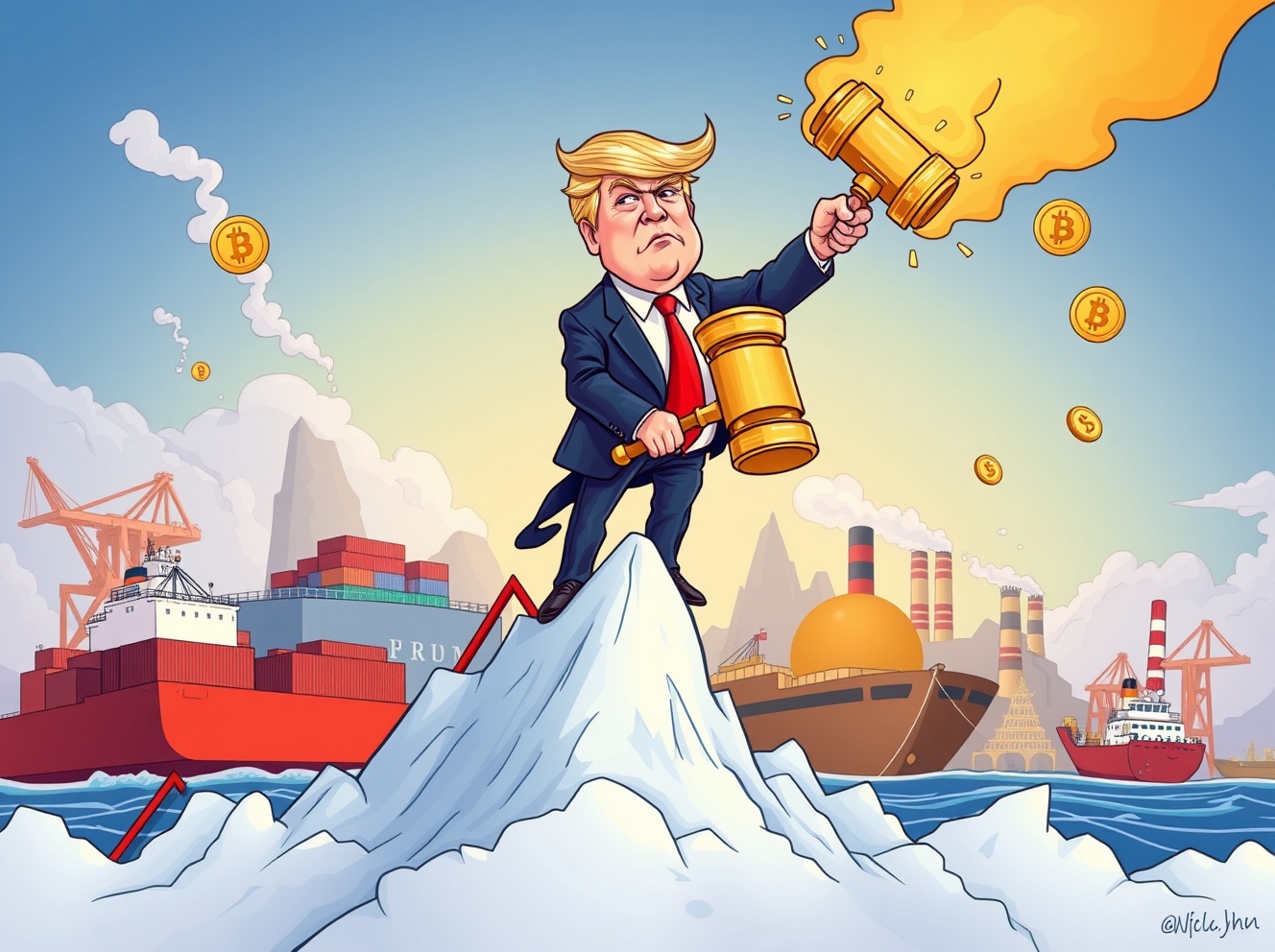Unveiling the Powerful Impact of Trump’s Tariff Policies on Markets

BitcoinWorld
Unveiling the Powerful Impact of Trump’s Tariff Policies on Markets
For those deeply engaged in the dynamic world of cryptocurrencies, understanding the broader economic landscape is crucial. Recently, former U.S. President Donald Trump made headlines by attributing a significant stock market boom directly to his administration’s tariff policies. This bold claim sparks important questions about how government interventions can shape financial markets, and by extension, what it means for digital assets. Let’s dive into this complex relationship.
What Exactly Are Tariff Policies and How Do They Work?
Before we analyze the impact, it is helpful to understand what tariff policies actually entail. A tariff is essentially a tax imposed by a government on imported goods or services. Think of it as a border tax. Governments implement tariffs for various reasons, primarily to protect domestic industries from foreign competition or to generate revenue.
When a country applies tariffs, it makes imported goods more expensive for consumers and businesses. This can encourage people to buy domestically produced alternatives. However, it also means that imported components for manufacturing might become pricier, potentially increasing costs for local businesses. The effects of these tariff policies can be far-reaching and complex.
Did Trump’s Tariff Policies Really Fuel a Stock Market Boom?
Donald Trump frequently asserted that his administration’s tariff policies were a key driver behind the robust performance of the U.S. stock market. His argument suggested that these tariffs, by promoting domestic production and reducing trade deficits, created a stronger economic foundation. This, in turn, supposedly boosted investor confidence and corporate profits.
However, the actual economic impact is a subject of ongoing debate among experts. While the stock market did experience significant growth during parts of Trump’s presidency, many economists point to a confluence of factors beyond just tariff policies. These often include:
- Tax Cuts: Major corporate tax reductions likely boosted company earnings.
- Deregulation: Efforts to reduce government oversight in various sectors.
- Global Economic Growth: A generally positive global economic environment.
- Monetary Policy: The Federal Reserve’s interest rate decisions also played a role.
It is challenging to isolate the impact of any single policy, such as tariff policies, from the broader economic environment. Markets are influenced by a multitude of interconnected variables.
The Ripple Effect: How Tariff Policies Can Touch Cryptocurrency
You might be wondering, “How do traditional economic policies like tariff policies relate to the often-independent world of cryptocurrency?” The connection, while not always direct, is significant. Macroeconomic trends and investor sentiment in traditional markets often spill over into the crypto space.
Here’s how:
- Investor Sentiment: When traditional markets face uncertainty due to trade wars or economic instability caused by tariff policies, investors might seek alternative assets. Sometimes, this leads them to “safe haven” assets, which can occasionally include cryptocurrencies like Bitcoin.
- Inflationary Pressures: Tariffs can increase the cost of goods, potentially leading to inflation. If investors worry about fiat currency losing purchasing power, they might look to decentralized digital assets as a hedge.
- Global Economic Health: Strong global economies generally foster greater risk appetite, which can benefit growth assets like cryptocurrencies. Conversely, economic downturns, potentially exacerbated by protectionist tariff policies, can lead to a flight from risk, impacting crypto prices.
Understanding these broader economic currents is vital for anyone navigating the crypto market.
Navigating Market Volatility: Actionable Insights for Investors
Given the intricate relationship between government policies, traditional markets, and cryptocurrencies, what can investors do? Staying informed about global economic shifts, including discussions around tariff policies, is a proactive step.
Consider these actionable insights:
- Diversify Your Portfolio: Do not put all your eggs in one basket. A diversified portfolio can help mitigate risks from specific market downturns.
- Stay Informed: Keep an eye on economic indicators, central bank decisions, and major policy announcements. These factors indirectly influence crypto markets.
- Long-Term Perspective: Cryptocurrency markets are known for their volatility. A long-term investment strategy can help weather short-term fluctuations driven by various economic narratives, including those concerning tariff policies.
By understanding the bigger picture, you can make more informed decisions.
In conclusion, while Donald Trump’s assertion that tariff policies solely drove a stock market boom is a complex claim with varying economic interpretations, it highlights the profound impact government policies can have on financial markets. For cryptocurrency enthusiasts, recognizing how these macroeconomic forces, from trade disputes to interest rates, can influence investor behavior and asset allocation is indispensable. The world of finance is interconnected, and understanding these links empowers you to better navigate its evolving landscape.
Frequently Asked Questions (FAQs)
Q1: What is the primary goal of implementing tariff policies?
A1: The primary goal of implementing tariff policies is often to protect domestic industries from foreign competition, encourage local production, and sometimes to generate government revenue.
Q2: How can tariff policies indirectly affect cryptocurrency prices?
A2: Tariff policies can affect cryptocurrency prices indirectly by influencing global economic stability, investor sentiment, and inflation expectations. For example, economic uncertainty caused by trade wars might lead investors to seek alternative assets, including cryptocurrencies.
Q3: Are tariff policies generally seen as beneficial for all sectors of an economy?
A3: No, tariff policies are not universally beneficial. While they might protect some domestic industries, they can also increase costs for consumers and businesses relying on imported goods, potentially leading to retaliatory tariffs from other countries.
Q4: What other factors, besides tariff policies, influence stock market performance?
A4: Many factors influence stock market performance, including corporate earnings, interest rates, tax policies, technological advancements, consumer confidence, and overall global economic growth.
Q5: Why is understanding traditional economic policies important for crypto investors?
A5: Understanding traditional economic policies like tariff policies is important for crypto investors because macroeconomic trends and shifts in investor sentiment in traditional markets often spill over and influence the demand and pricing of digital assets.
Q6: How can investors prepare for market volatility caused by economic policies?
A6: Investors can prepare for market volatility by diversifying their portfolios, staying informed about global economic indicators and policy changes, and adopting a long-term investment perspective.
Call to Action:
Did this article shed new light on the intricate connections between government policy and financial markets? Share your thoughts and insights with your network! Click the share buttons below to spread the word and spark a conversation about the economic forces shaping our world, including the exciting realm of cryptocurrencies.
To learn more about the latest crypto market trends, explore our article on key developments shaping Bitcoin institutional adoption.
This post Unveiling the Powerful Impact of Trump’s Tariff Policies on Markets first appeared on BitcoinWorld.
Unveiling the Powerful Impact of Trump’s Tariff Policies on Markets

BitcoinWorld
Unveiling the Powerful Impact of Trump’s Tariff Policies on Markets
For those deeply engaged in the dynamic world of cryptocurrencies, understanding the broader economic landscape is crucial. Recently, former U.S. President Donald Trump made headlines by attributing a significant stock market boom directly to his administration’s tariff policies. This bold claim sparks important questions about how government interventions can shape financial markets, and by extension, what it means for digital assets. Let’s dive into this complex relationship.
What Exactly Are Tariff Policies and How Do They Work?
Before we analyze the impact, it is helpful to understand what tariff policies actually entail. A tariff is essentially a tax imposed by a government on imported goods or services. Think of it as a border tax. Governments implement tariffs for various reasons, primarily to protect domestic industries from foreign competition or to generate revenue.
When a country applies tariffs, it makes imported goods more expensive for consumers and businesses. This can encourage people to buy domestically produced alternatives. However, it also means that imported components for manufacturing might become pricier, potentially increasing costs for local businesses. The effects of these tariff policies can be far-reaching and complex.
Did Trump’s Tariff Policies Really Fuel a Stock Market Boom?
Donald Trump frequently asserted that his administration’s tariff policies were a key driver behind the robust performance of the U.S. stock market. His argument suggested that these tariffs, by promoting domestic production and reducing trade deficits, created a stronger economic foundation. This, in turn, supposedly boosted investor confidence and corporate profits.
However, the actual economic impact is a subject of ongoing debate among experts. While the stock market did experience significant growth during parts of Trump’s presidency, many economists point to a confluence of factors beyond just tariff policies. These often include:
- Tax Cuts: Major corporate tax reductions likely boosted company earnings.
- Deregulation: Efforts to reduce government oversight in various sectors.
- Global Economic Growth: A generally positive global economic environment.
- Monetary Policy: The Federal Reserve’s interest rate decisions also played a role.
It is challenging to isolate the impact of any single policy, such as tariff policies, from the broader economic environment. Markets are influenced by a multitude of interconnected variables.
The Ripple Effect: How Tariff Policies Can Touch Cryptocurrency
You might be wondering, “How do traditional economic policies like tariff policies relate to the often-independent world of cryptocurrency?” The connection, while not always direct, is significant. Macroeconomic trends and investor sentiment in traditional markets often spill over into the crypto space.
Here’s how:
- Investor Sentiment: When traditional markets face uncertainty due to trade wars or economic instability caused by tariff policies, investors might seek alternative assets. Sometimes, this leads them to “safe haven” assets, which can occasionally include cryptocurrencies like Bitcoin.
- Inflationary Pressures: Tariffs can increase the cost of goods, potentially leading to inflation. If investors worry about fiat currency losing purchasing power, they might look to decentralized digital assets as a hedge.
- Global Economic Health: Strong global economies generally foster greater risk appetite, which can benefit growth assets like cryptocurrencies. Conversely, economic downturns, potentially exacerbated by protectionist tariff policies, can lead to a flight from risk, impacting crypto prices.
Understanding these broader economic currents is vital for anyone navigating the crypto market.
Navigating Market Volatility: Actionable Insights for Investors
Given the intricate relationship between government policies, traditional markets, and cryptocurrencies, what can investors do? Staying informed about global economic shifts, including discussions around tariff policies, is a proactive step.
Consider these actionable insights:
- Diversify Your Portfolio: Do not put all your eggs in one basket. A diversified portfolio can help mitigate risks from specific market downturns.
- Stay Informed: Keep an eye on economic indicators, central bank decisions, and major policy announcements. These factors indirectly influence crypto markets.
- Long-Term Perspective: Cryptocurrency markets are known for their volatility. A long-term investment strategy can help weather short-term fluctuations driven by various economic narratives, including those concerning tariff policies.
By understanding the bigger picture, you can make more informed decisions.
In conclusion, while Donald Trump’s assertion that tariff policies solely drove a stock market boom is a complex claim with varying economic interpretations, it highlights the profound impact government policies can have on financial markets. For cryptocurrency enthusiasts, recognizing how these macroeconomic forces, from trade disputes to interest rates, can influence investor behavior and asset allocation is indispensable. The world of finance is interconnected, and understanding these links empowers you to better navigate its evolving landscape.
Frequently Asked Questions (FAQs)
Q1: What is the primary goal of implementing tariff policies?
A1: The primary goal of implementing tariff policies is often to protect domestic industries from foreign competition, encourage local production, and sometimes to generate government revenue.
Q2: How can tariff policies indirectly affect cryptocurrency prices?
A2: Tariff policies can affect cryptocurrency prices indirectly by influencing global economic stability, investor sentiment, and inflation expectations. For example, economic uncertainty caused by trade wars might lead investors to seek alternative assets, including cryptocurrencies.
Q3: Are tariff policies generally seen as beneficial for all sectors of an economy?
A3: No, tariff policies are not universally beneficial. While they might protect some domestic industries, they can also increase costs for consumers and businesses relying on imported goods, potentially leading to retaliatory tariffs from other countries.
Q4: What other factors, besides tariff policies, influence stock market performance?
A4: Many factors influence stock market performance, including corporate earnings, interest rates, tax policies, technological advancements, consumer confidence, and overall global economic growth.
Q5: Why is understanding traditional economic policies important for crypto investors?
A5: Understanding traditional economic policies like tariff policies is important for crypto investors because macroeconomic trends and shifts in investor sentiment in traditional markets often spill over and influence the demand and pricing of digital assets.
Q6: How can investors prepare for market volatility caused by economic policies?
A6: Investors can prepare for market volatility by diversifying their portfolios, staying informed about global economic indicators and policy changes, and adopting a long-term investment perspective.
Call to Action:
Did this article shed new light on the intricate connections between government policy and financial markets? Share your thoughts and insights with your network! Click the share buttons below to spread the word and spark a conversation about the economic forces shaping our world, including the exciting realm of cryptocurrencies.
To learn more about the latest crypto market trends, explore our article on key developments shaping Bitcoin institutional adoption.
This post Unveiling the Powerful Impact of Trump’s Tariff Policies on Markets first appeared on BitcoinWorld.

